Lesson Plan英语教案模板
- 格式:doc
- 大小:38.50 KB
- 文档页数:2

Lesson Plan TemplateLesson Title: [Insert Lesson Title Here]Grade Level: [Insert Grade Level Here]Subject: [Insert Subject Here]Duration: [Insert Duration Here]Objectives:Cognitive: [Insert specific learning objectives related to knowledge and understanding]Affective: [Insert specific learning objectives related to attitudes and feelings]Psychomotor: [Insert specific learning objectives related to physical skills]Materials Needed:[List all materials and resources needed for the lesson]Standards Addressed:[Insert relevant educational standards or benchmarks]Vocabulary:[List key vocabulary words and definitions]Introduction (5-10 minutes):Hook/Attention Grabber: [Describe an engaging activity or question to capture students’ interest]Objective Sharing: [Explain the lesson objectives to the students]Prior Knowledge Activation: [Discuss what students already know about the topic]• • • • • • • • •Instruction (15-20 minutes):Direct Instruction: [Provide detailed steps for teaching the content,including explanations, examples, and demonstrations]Guided Practice: [Describe activities where students practice new skills with teacher support]Check for Understanding: [List questions or formative assessments to gauge student comprehension]Independent Practice (10-15 minutes):[Describe activities where students practice skills independently]Closure (5-10 minutes):Summary: [Recap the main points of the lesson]Student Reflection: [Ask students to reflect on what they learned]Preview of Next Lesson: [Briefly introduce what will be covered in the next lesson]Assessment:Formative: [Describe how you will assess student understanding during the lesson]Summative: [Describe any end-of-lesson assessments, such as quizzes or projects]Differentiation:For Advanced Learners: [Describe how you will challenge advanced students]For Struggling Learners: [Describe how you will support students who need extra help]Extensions:[List additional activities or projects for students who finish early or want to explore the topic further]Reflection:[Space for teacher to reflect on the lesson’s effectiveness and areas for improvement]• • • • • • • • • • • • •Example Lesson PlanLesson Title: Introduction to PhotosynthesisGrade Level: 5th GradeSubject: ScienceDuration: 45 minutesObjectives:Cognitive: Students will understand the basic process ofphotosynthesis.Affective: Students will appreciate the importance of plants in the ecosystem.Psychomotor: Students will create a diagram of the photosynthesis process.Materials Needed:Whiteboard and markersChart paper and markersPhotosynthesis worksheetPlant samplesVideo on photosynthesisStandards Addressed:NGSS 5-LS1-1: Support an argument that plants get the materials they need for growth chiefly from air and water .Vocabulary:PhotosynthesisChlorophyllCarbon dioxideOxygenGlucose• • • • • • • • • • • • • •Introduction (5-10 minutes):Hook/Attention Grabber: Show a short video clip of plants growing in fast motion.Objective Sharing: Explain that today we will learn how plants make their own food through photosynthesis.Prior Knowledge Activation: Ask students what they know about how plants grow.Instruction (15-20 minutes):Direct Instruction: Explain the process of photosynthesis using a diagram on the whiteboard. Highlight the role of sunlight, water , and carbon dioxide.Guided Practice: Work through a photosynthesis worksheet as a class,filling in the blanks and labeling parts of the process.Check for Understanding: Ask students to explain the process in their own words and answer questions about the diagram.Independent Practice (10-15 minutes):Students will draw their own diagram of the photosynthesis process and label each part.Closure (5-10 minutes):Summary: Recap the main points of photosynthesis.Student Reflection: Ask students to share one new thing they learned about plants.Preview of Next Lesson: Introduce the next topic: the role of plants in the food chain.Assessment:Formative: Monitor student participation during guided practice and check for understanding.Summative: Review the diagrams students create for accuracy and completeness.Differentiation:For Advanced Learners: Provide additional reading material on the chemical equations involved in photosynthesis.• • • • • • • • • • • • •For Struggling Learners: Pair students with a buddy for the independent practice activity.Extensions:Research project on different types of plants and their photosynthesis processes.Reflection:[Teacher’s notes on what worked well and what could be improved for next time]• • •。
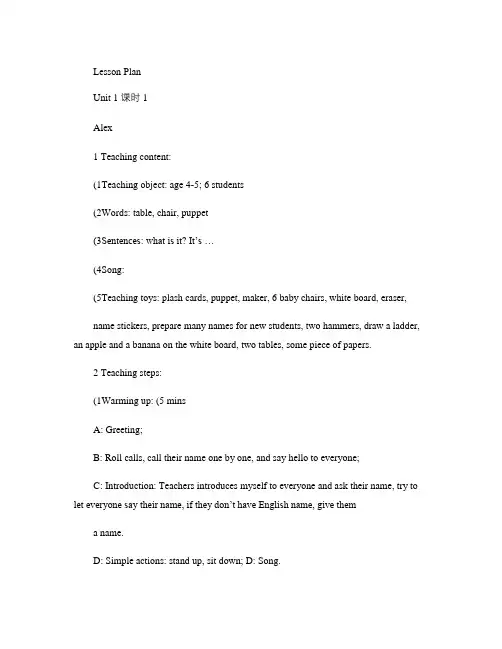
Lesson PlanUnit 1 课时1Alex1 Teaching content:(1Teaching object: age 4-5; 6 students(2Words: table, chair, puppet(3Sentences: what is it? It’s …(4Song:(5Teaching toys: plash cards, puppet, maker, 6 baby chairs, white board, eraser,name stickers, prepare many names for new students, two hammers, draw a ladder, an apple and a banana on the white board, two tables, some piece of papers.2 Teaching steps:(1Warming up: (5 minsA: Greeting;B: Roll calls, call their name one by one, and say hello to everyone;C: Introduction: Teachers introduces myself to everyone and ask their name, try to let everyone say their name, if they don’t have English name, give thema name.D: Simple actions: stand up, sit down; D: Song.(2Words presentation: (20 minsA: Words: chair, puppet, and table. Real object; flash cards; CDB: Practice for words: Together, show the flash cards one by one, loud and small sound and tone to say every word.Individual: by kissing, touching and kicking to say the word. Hammer gameGroup work: two groups, each team s students.Start single – Name – Rules – Game – The end singleSpread the flash cards on the floor, when the teacher says aword and they need to hit the word and say it. The winnercan be the teacher one time and say a word let the otherstudent hit it, besides; the winner group can have one stepup the ladder. The winner group can have two stars for eachone. Collect the flash cards and do the ends single.(10 minsC: Production: Check. Racing game; two groups. (10 minsStart single -- Name the gameRules: let a student do an example with the teacher; make two lines –the top two students hold the hammer before the teacher givethe single;When the teacher says a word the student goes and find it, andsay the word.The winner group can have two starts.Start – the end single(3Sentences presentation: (15 minsA: answer: listen to the CDB: practice: It’s …Individually: craw craw craw (game.Rules: place two tables end to end, make a line and they craw under the table from the top to the end, the teacher will waiting for them at the endof the table. The teacher says: “what is it?”T hen each kid can get a chanceto practice: It’s …Together: what is it? It’s …Group work: two groups. Keep going the ladder game.Now the students ask the teacher question. The group that louder than another one can have one step up,C: production: checkTwo teams: racing gameSingle – name – rulesRules: the teacher opposite to the students, when the teacher says goes, theyjump/craw/ hop/run to the teach er; the teacher says: “what is it?” the first one who can answer the question and jump/craw/… back to the line, they will win.Start – the end actionCommunication: five stepsRules: each student draw a picture (chair, table and puppet; the teacher ask a student do an example, the teacher says: “what is it?” the student look at the teacher’s picture and say the answer, then the student ask the teacher the question,, after that they change their picture and go to find others do the same thing; when they change one time they can get a poker. The winner could be the one have the most pokers.Start – endThe minutes breakThe second class (40 minsTeaching steps:(1Review “what is it, It’s …” (5 mins(2Letter A a B b (10 mins flash cards A a B b same hammer game.(3Hand out some pictures to the students: chair table puppet; trace A aB b. (when the students do the drawing things the teacher canreview again by individually (15 mins(4Wrap up (10mins: review all the stuff (5 mins;Line up, train game;Homework: tell their parentsGoodbye :( If some parents want to know their kids’ behavior you can let them wait after the class.。
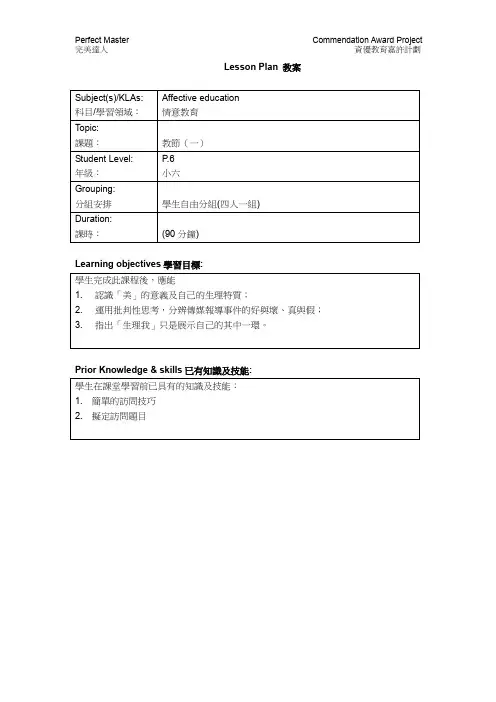
Lesson Plan 教案
Learning objectives學習目標:
Prior Knowledge & skills已有知識及技能:
教學活動及流程:
# 展示在教學活動中為照顧高能力/資優學生而調適的教學內容和策略。
學習評估:
Lesson Plan 教案
Learning objectives學習目標:
Prior Knowledge & skills已有知識及技能:
教學活動及流程:
#展示在教學活動中為照顧高能力/資優學生而調適的教學內容和策略。
學習評估:
Lesson Plan 教案
Learning objectives學習目標:
Prior Knowledge & skills已有知識及技能:
教學活動及流程:
香港進食失調康復會有限公司派員到校主講《瘦身文化面面觀》講座
全級進行
# 展示在教學活動中為照顧高能力/資優學生而調適的教學內容和策略。
學習評估:
Lesson Plan 教案
Learning objectives學習目標:
Prior Knowledge & skills已有知識及技能:
教學活動及流程:
#展示在教學活動中為照顧高能力/資優學生而調適的教學內容和策略。
學習評估:
Lesson Plan 教案
Learning objectives學習目標:
Prior Knowledge & skills已有知識及技能:
教學活動及流程:
#展示在教學活動中為照顧高能力/資優學生而調適的教學內容和策略。
學習評估:。
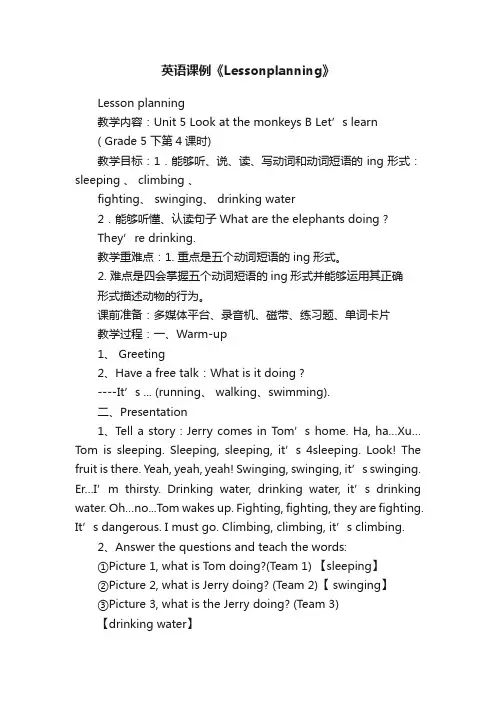
英语课例《Lessonplanning》Lesson planning教学内容:Unit 5 Look at the monkeys B Let’s learn( Grade 5 下第4课时)教学目标:1.能够听、说、读、写动词和动词短语的ing形式:sleeping 、 climbing 、fighting、 swinging、 drinking water2.能够听懂、认读句子What are the elephants doing ?They’re drinking.教学重难点:1. 重点是五个动词短语的ing形式。
2. 难点是四会掌握五个动词短语的ing形式并能够运用其正确形式描述动物的行为。
课前准备:多媒体平台、录音机、磁带、练习题、单词卡片教学过程:一、Warm-up1、 Greeting2、Have a free talk:What is it doing ?----It’s ... (runnin g、 walking、swimming).二、Presentation1、Tell a story:Jerry comes in Tom’s home. Ha, ha…Xu… Tom is sleeping. Sleeping, sleeping, it’s 4sleeping. Look! The fruit is there. Yeah, yeah, yeah! Swinging, swinging, it’s swinging. Er…I’m thirsty. Drinking water, drinking water, it’s drinking water. Oh…no...Tom wakes up. Fighting, fighting, they are fighting. It’s dangerous. I must go. Climbing, climbing, it’s climbing.2、Answer the questions and teach the words:①Picture 1, what is Tom doing?(Team 1) 【sleeping】②Picture 2, what is Jerry doing? (Team 2)【 swinging】③Picture 3, what is the Jerry doing? (Team 3)【drinking water】④Picture 4, what are Tom and Jerry doing? (Team 4)【fighting】⑤Picture 5, what is Jerry doing? (抢答) 【climbing】3、Teaching grammar: 现在进行时【be动词 + 动词ing形式】三、Practice1、Read after the tape2、Read after the teacher3、Read in the whole class4、Read in the group of 45、Check reading四、Production1、Play a game—You are mine请两名同学上来猜拳赢单词,赢得改单词的同学要带领全班读吹该单词,最后看哪个同学赢得最多的单词。
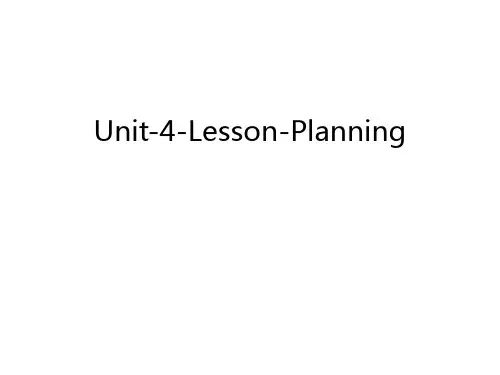

Lesson PlanTeaching contents: Asking the colorDescription of students: Junior 1(40 students)Time and date: 14:00-14:40, Thursday, 22th September.2012Teaching aids: PPT, tape recorder, cards, school bagsTeaching objectives: 1. Students can introduce and describe the color of their things to others.2. Students can ask the color and things they don't knowMain structure: What is this? It is...What color is it? It is...Main vocabulary: color red yellow green blue black whiteLearning strategies: Listening to the color songGuessing gameGroup cooperation in the role playBuilding up confidence in presentationTeaching procedure:Step1: Warm up (3 min)Teacher says "Good morning boys and girls." students will say "Good morning Miss Zheng" Teacher asks "How is the weather today?" The answer of the students' will depend on the real weather that day. Next, teacher will ask "How about tomorrow? Do you remember?" The answer of the students' depends on the weather that day. Then teacher will ask the students" Do you remember the song we learned yesterday? ABC song, do you remember? Now let's sing it together "They sing the ABC song together. After that teacher will ask them "Do you like songs? Let's enjoy another song. Please listen carefully and think about one question, what is the song about?" So teacher will play the color song for them.Step 2: Teach (6 min)Teacher asks the students "What is this song about?" It is about color, right? Look at the blackboard and read after me color... "The students follow. Teacher says, "If we want to ask others the color we should say-what color is it, now read after me, what color is it..." the students follow. Teacher takes out some cards and asks "Now all eyes on me, what are they?" The students will answer "They are cards." Teacher says "Last class, we learned letters right? Now I'll ask you some questions about these letters, are you ready? The students will answer "Yes!" Next, teacher will take out these cards one by one and ask them "What is this?" After the students answered teacher will ask them "what color is it" and lead them to red these colors. The contents of these cards are "white u, red v, blue w, yellow x, green y, and black z"Step3: Guessing game (6 min)At first, the teacher will divide the whole class into 4 groups and let them choose one color as their group name, and tell them the rules. If they can be active inthese games they can get stars, and the group which get the most stars is the winner.Then Teacher will say "now let's play a guessing game. Look at the picture." Teacher will point the picture and show them "This is a piece of cloth, and behind the cloth there is something. I leave some parts of it out, so please base on these parts to guess what it is and what color it is, understand?...Let's begin..." Then the teacher will ask the whole class, or just one student, or let two students ask each other, or let the students ask the teacher. The questions are "what is this? What color is it?"The contents of these pictures are "red apple, yellow banana, green tree, blue sky, white clouds, and black Chinese ink". These students who asked or answered questions in the game can get stars for their team.Step4: Counting color game (2 min)Teacher will show the students a picture of Olympic rings, and let the students to count how many colors are there in the picture and read them out. If someone can count them out and say it out accurately he or she can get one star for his or her group. Step5: Make conversations (9 min)Teacher will let the students take out their school bags and introduce their things to their group members, they can ask any thing about the things, but they must ask the color (5 min). Then they should show their conversation to the whole class (4 min).Step6: Write a passage (13 min)The teacher will let the students to think about their bed room, and write a passage to describe their bed room and those things in their bedroom (9min).Then choose some students read their passage for the whole class (4 min). Step7: Homework (1 min)Draw a picture of the things you like and paint the color you like most on it. ReflectionStrong points:Smiles sweet, good pronunciation, natural transition, logical organization.Shortcomings:Teaching contents looks not so rich, those cards can be better, rewarding system can be more attractive and interesting.。
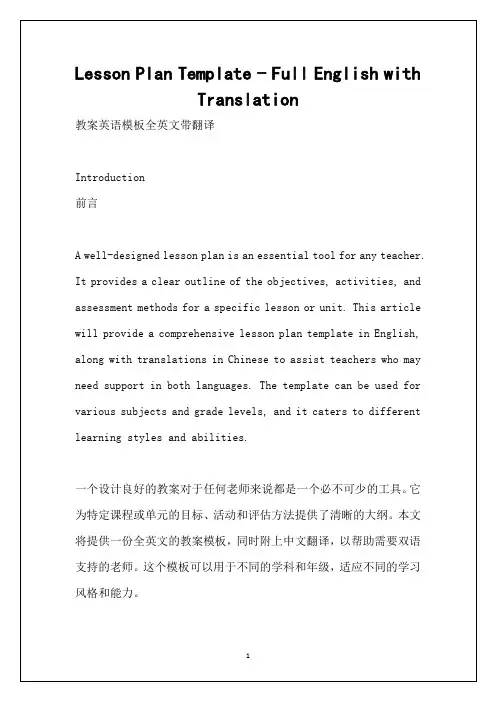
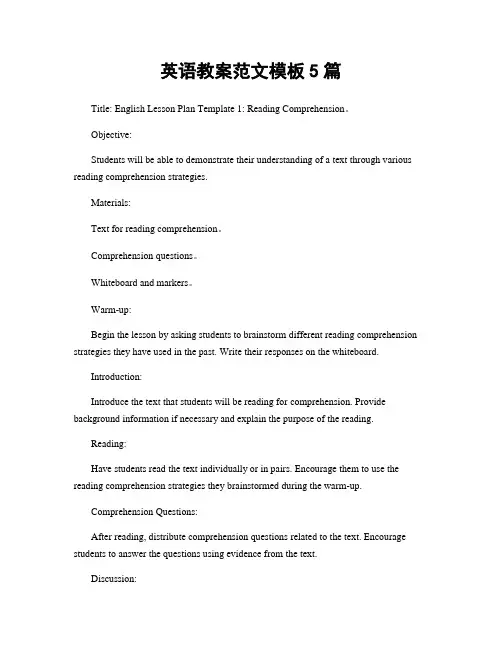
英语教案范文模板5篇Title: English Lesson Plan Template 1: Reading Comprehension。
Objective:Students will be able to demonstrate their understanding of a text through various reading comprehension strategies.Materials:Text for reading comprehension。
Comprehension questions。
Whiteboard and markers。
Warm-up:Begin the lesson by asking students to brainstorm different reading comprehension strategies they have used in the past. Write their responses on the whiteboard.Introduction:Introduce the text that students will be reading for comprehension. Provide background information if necessary and explain the purpose of the reading.Reading:Have students read the text individually or in pairs. Encourage them to use the reading comprehension strategies they brainstormed during the warm-up.Comprehension Questions:After reading, distribute comprehension questions related to the text. Encourage students to answer the questions using evidence from the text.Discussion:Lead a class discussion about the text and the comprehension questions. Encourage students to share their answers and explain their reasoning.Extension Activity:For an extension activity, have students write a short summary of the text or create a visual representation (such as a poster or a drawing) to demonstrate their understanding.Assessment:Assess students' understanding based on their responses to the comprehension questions, their participation in the discussion, and their extension activity.Closure:Conclude the lesson by reviewing the reading comprehension strategies that students used and discussing how they can apply these strategies to other texts.Title: English Lesson Plan Template 2: Vocabulary Building。
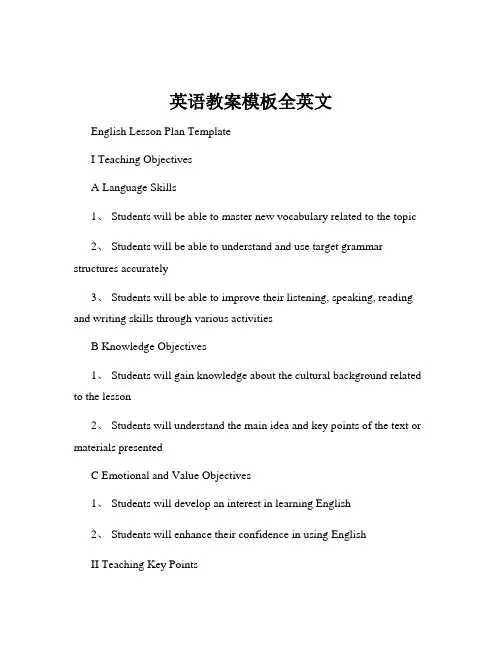
英语教案模板全英文English Lesson Plan TemplateI Teaching ObjectivesA Language Skills1、 Students will be able to master new vocabulary related to the topic2、 Students will be able to understand and use target grammar structures accurately3、 Students will be able to improve their listening, speaking, reading and writing skills through various activitiesB Knowledge Objectives1、 Students will gain knowledge about the cultural background related to the lesson2、 Students will understand the main idea and key points of the text or materials presentedC Emotional and Value Objectives1、 Students will develop an interest in learning English2、 Students will enhance their confidence in using EnglishII Teaching Key PointsA VocabularyIntroduce and explain new words and phrases that are essential for understanding the lessonB GrammarHighlight and explain the target grammar structure, and provide sufficient practiceC Text ComprehensionHelp students understand the main idea, details and logical structure of the textIII Teaching Difficult PointsA Complicated Grammar StructuresSolve students' confusion and difficulties in understanding and applying complex grammar rulesB Abstract ConceptsMake abstract or difficult concepts easier to understand through vivid examples and explanationsC Cultural DifferencesHelp students bridge the gap in understanding cultural differences to better comprehend the languageIV Teaching MethodsA Communicative ApproachEncourage students to communicate and interact in English to improve their language proficiencyB TaskBased LearningAssign various tasks to students to enhance their problemsolving skills and language application abilityC Multimedia TeachingUse pictures, videos, and audio materials to make the lesson more vivid and interestingV Teaching AidsA Textbooks and WorkbooksUse the prescribed textbooks and supplementary workbooks for systematic teaching and practiceB Multimedia ResourcesPrepare PPTs, videos, audio clips, and online materials to support teachingC Realia and ModelsUse real objects or models to help students understand and remember the knowledge betterVI Teaching ProcedureA Leadin1、 Start the class with a warmup activity such as a short video, a song, or a simple question to arouse students' interest and attention2、 Relate the warmup to the topic of the lesson and introduce the main learning objectivesB Presentation1、 Present new vocabulary and grammar through examples, pictures, or context2、 Explain the meaning and usage of the new language items clearly and simplyC Practice1、 Provide various exercises for students to practice the new vocabulary and grammar, such as fillintheblanks, sentencemaking, and translation2、 Organize pair or group work to allow students to practice communicating with each other using the new languageD Reading/Listening Comprehension1、 Present a reading or listening text related to the topic2、 Set comprehension questions to guide students to understand the main idea, details and key information of the textE Production1、 Ask students to apply the language they have learned to reallife situations, such as roleplay, debate, or composition writing2、 Provide feedback and correction to students' performanceF SummarySummarize the key points and language points learned in the lesson to reinforce students' memoryG HomeworkAssign appropriate homework to consolidate what has been learned in class, such as exercises, reading or writing tasksVII Blackboard DesignWrite the key vocabulary, grammar rules and important points on the blackboard during the lesson for students to refer toVIII Teaching ReflectionAfter the lesson, reflect on the teaching process and students' learning performance, summarize the strengths and weaknesses, and make improvements for future teachingThis is a basic template for an English lesson plan Depending on the specific content and teaching requirements, teachers can make appropriate adjustments and enrichments The key is to design a lesson that is interesting, effective and suitable for students' language level and learning needs。
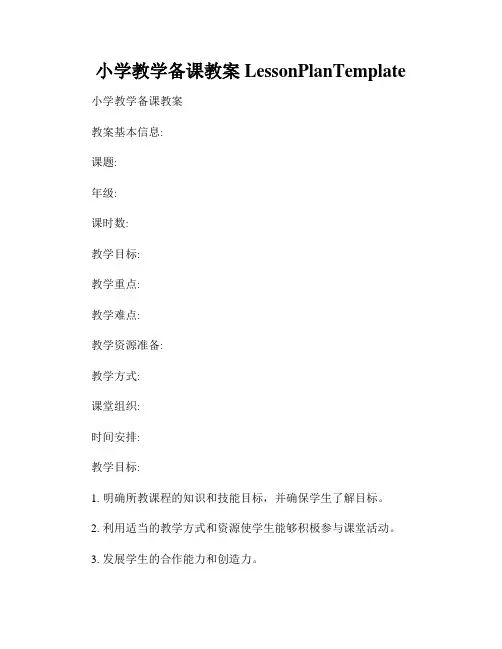
小学教学备课教案LessonPlanTemplate 小学教学备课教案教案基本信息:课题:年级:课时数:教学目标:教学重点:教学难点:教学资源准备:教学方式:课堂组织:时间安排:教学目标:1. 明确所教课程的知识和技能目标,并确保学生了解目标。
2. 利用适当的教学方式和资源使学生能够积极参与课堂活动。
3. 发展学生的合作能力和创造力。
4. 培养学生的问题解决能力和批判性思维。
教学重点和难点:本课的重点是:本课的难点是:教学准备和教学资源:教学准备材料:教学资源准备:教学步骤:步骤一: 导入在导入环节,老师可以运用一些引人入胜的素材,例如一段视频、一张图片、一个故事等,来引起学生的兴趣并激发他们的思考。
步骤二: 介绍新知识在这个步骤中,老师将向学生介绍本节课的新知识。
可以运用多媒体教具或板书等方式,将知识点清晰明了地呈现给学生。
步骤三: 课堂实践在这个步骤中,学生将有机会运用所学的知识进行实践。
老师可以设计一些小组活动、角色扮演或实验等让学生积极参与并互动的活动。
步骤四: 巩固知识在这个步骤中,老师将对刚才的教学内容进行巩固。
可以设计一些练习题、小测验或讨论等方式,让学生能够再次运用所学知识。
步骤五: 总结与归纳在这个步骤中,老师将对本节课的内容进行总结与归纳。
可以提出一些问题让学生思考并给出答案,或者组织学生进行小结发言等。
步骤六: 作业布置在这个步骤中,老师将给学生布置一些作业,以巩固他们所学的知识。
教学方式和组织:本节课采用以下教学方式:本节课的组织形式为:时间安排:本节课的时间安排如下:总结:通过本节课的教学,学生能够达到预期的教学目标,并且有机会积极参与到课堂活动中。
教师合理使用教学方法和资源,让学生的学习效果得到了提升。
希望学生们能够在作业中巩固所学知识,取得更好的学习成果。
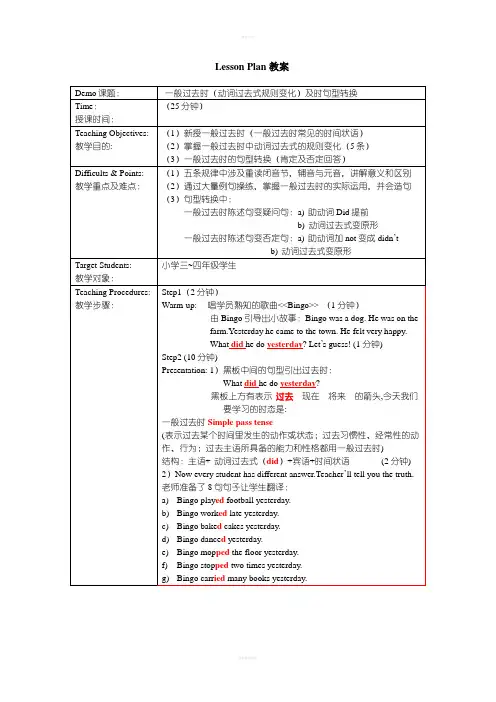
Lesson Plan教案Step1(2分钟)Warm-up: 唱学员熟知的歌曲<<Bingo>> (1分钟)由Bingo引导出小故事:Bingo was a dog. He was on thefarm.Yesterday he came to the town. He felt very happy.What did he do yesterday? Let’s guess! (1分钟)Step2 (10分钟)Presentation: 1)黑板中间的句型引出过去时:What did he do yesterday?黑板上方有表示过去现在将来的箭头,今天我们要学习的时态是:一般过去时Simple pass tense(表示过去某个时间里发生的动作或状态;过去习惯性、经常性的动作、行为;过去主语所具备的能力和性格都用一般过去时)结构:主语+ 动词过去式(did)+宾语+时间状语(2分钟) 2)Now every student has different answer.Teacher’ll tell you the truth. 老师准备了8句句子让学生翻译:a)Bingo play ed football yesterday.b)Bingo work ed late yesterday.c)Bingo bake d cakes yesterday.d)Bingo dance d yesterday.e)Bingo mop ped the floor yesterday.f)Bingo stop ped two times yesterday.g)Bingo carr ied many books yesterday.. . .。
竭诚为您提供优质文档/双击可除lesson,plan,模板篇一:lessonplan模板lessonplanunit2lesson1aperfectday(示例)本课是第xx单元第xx课。
本单元围绕xxx话题。
本课计划按两次课完成:第一次课关于warmingupandreadingcomprehension;第二次课xxxxx。
......(示例)period1:warmingupandreadingcomprehension(示例)(90min)objectives1.knowledgeobjectives:1)masterthenewwordsandexpressions2)tousetimelinkers,especiallyadverbsandconjunctions2.abilityobjectives:1)learnaboutthegeneralideaofthetextthroughfastreadi ng2)findoutthedetailedorspecificinformationthroughint ensivereading3)practicestudents’abilitytousethestrategyofpredicationandreference3.emotionobjectives:1)tolearntheheroicspiritofyangliwei2)togetandarrangetheinformationaboutspaceship3)todescribetheprocessoftheflightandthefeelingsofya ngbythewordsandexpressionslearnedinthislesson(此部分可根据实际情况删减)contents1.words:astronaut,flight,launch,rocket,atmosphere,helicopte r,parachute,gravity,manndspaceship,separate…from,becauseof,letout,millionsof......2.expressions:separatefrom与……分离,becauseof因为,由于,liftoff起飞,升空,发射......3.sentences:1)thespaceship,calledshenzhouⅤ,wascarryingchina’sfirstastronaut,yangliwei.2)whenthespaceshipwasdoingitsseventhcircle,yangliwe ishowedtheflagsofchinaandtheunitednations,expressin gthewishesofthechinesepeopletoexploreandusespacepea cefully.municativetasks:questionscanbebasedondetailsin thetext.whydopeoplethinkyangliweiisaherowhatcanwelearnfromyangliwei ……keypointsanddifficulties1.findoutthemainideaanddetailedinformationthroughex tensiveandintensivereading.2.todescribetheprocessoftheflightbythewordsandexpressionslearnedinthislesson.teachingapproachestask-basedteaching,scanning,intensivereading,rolepl ay,pair-worksdebutlaunch.长征七号运载火箭20xx年6月25日晚在海南文昌发射场首飞成功。
Lesson planUnit 2 What’s your telephone number ?英语教育2班1406010202Ⅰ.Background information:a) Grade: Sevenb) Class: Twoc) Number:50d)Duration:40minⅡ.Teaching contents:a) Unit: Twob) Period: Period 1c) Part: Section AⅢ.Teaching objectives:a) Knowledge objectives:●Can listen , read and recognize ten number wordsb) Ability objectives:●Improve the students' comprehensive ability of using languageC) Emotion objectives:●Students can talk based on content, enhance the confidenceand interest in English learning.Ⅳ.Key points:a) difficult points :●How to accord to the actual life, broaden the application ofdigital.b) important points:●Master the sentence patterns “What is your telephone number ?My telephone number is…”Ⅴ.Teaching method:Communicative language teachingⅥ.Teaching aids:a) Multimedia devices and PPT documentsb) Small prizec) number cardⅦ.Teaching procedures:Step1:Warm-up (5min)a) GreetingsT: Good morning, boys and girls.Ss: Good morning, Miss Zhu.T: How are you?Ss: Fine, thank youT:Ok, before the class, we will hear a song. After listen tell me what do you hear. (say it in Chinese)b) Use computer play a song “Ten little Indians”T: Listen to this song ,What did you hear ?(say it in Chinese)S:Oen S:Two,five S:nine,four S:Number …(Who answerit, win the star for his/her group.)T:Well. You are right. Now listen to me.(wait students be quiet) One,two,three,four,five,six,seven,eight,nine.( speak loudly and slowly)Yes or no?Ss: Yes!Step2: Learn new words(15min)T:(opens the multi-media showing the PPT)T: What’s this? (ask twice or more)Ss: 电话。
八年级【英语】说课稿Lesson planTeaching material: Module 1 Unit 3 Dealing with trouble, Oxford English8A (Page 39)Period: The 2nd periodTeaching aids: Multi-media, textbook s, students’ sheets, board, etc.一、学生情况分析学生大多乐于参与学习英语且学习习惯较为良好。
针对大部分学生将来会攻读国际文凭课程的情况,教师将培养其长篇阅读能力作为目标之一。
本节课上教师将通过阅读和讨论来引导和启发学生深层次的思维,并鼓励其用英语交流,从而增强自信心。
二、教材分析本节课是改编后的牛津教材8A第3单元第2课时,在本课前已完成了生词等的教授。
根据学情,学生在小学阶段及中学六、七年级已经学习过一般过去时并反复操练和运用,因此本课课文阅读篇目“Dealing with trouble”教学目标的设定重点是培养学生的阅读技能,并通过讨论和辩论帮助学生积极思考和挖掘故事表层文本下所蕴含的深刻道理。
三、教学目标制定:语言知识与技能目标:全班同学能通过运用快速阅读、略读和查读等阅读技能理解课文大意和寻找相关信息;大部分同学能通过阅读和讨论本课课文后,挖掘作者的观点和态度等。
能力目标:1.培养学生有效阅读较长篇幅文章的能力。
2.启发学生的思考能力,培养其用英语表达自己观点的自信心。
情感/态度/价值观目标:1.在宽松的学习氛围中,激发学生的创新思维,鼓励学生用英语表达自己的想法,获得成功体验和自信心。
2.帮助学生认识到:在别人遇到麻烦事时即要提供帮助,且要采取机智灵活的办法解决麻烦。
四、教学策略方法:对初二学生而言,英语阅读从简单的对话和短文逐渐提升到了篇幅较长、难度较高、内容比较复杂的较长篇幅课文。
怎样帮助学生有效率的阅读并理解作者的观点和态度是我首先要考虑的。
LESSON PLANWhat’s your name?一、背景信息1. 主题语境:人与社会——人际沟通2. 语篇类型:对话3. 授课学生和时长:幼升小学生40分钟4. 教学材料分析:本课教学内容是一首名为What’s your name的歌曲,这首歌通过轻快的旋律对目标句型“What’s your nam e?”, “My name is xx”, “Nice to meet you”不断复现,从而使学习者自然习得如何询问姓名,介绍自己的姓名,以及如何向第一次见的人打招呼。
二、教学目标本节课结束后,学生能够:1.听懂基本的课堂指令并且能够按指令做;2.听懂,会说“What’s your name?”, “My name is xx”, “Nice to meet you”等句子;3.积极参与课堂活动,形成在课堂上尽量说英语的习惯四、教学资源:多媒体课件、视频、姓名贴纸、黑板和粉笔。
五、教学过程步骤教学活动设计意图互动时间&模式Step 1 Review 1.T says some sentences learned last classlike“Hi, everyone”, “one two…”, etc.5’CWIWStep 21st Listening T plays the video for the first time witho utinterv als, a fter watching, asks what did theyhear just now?T takes ou t a box and lets all the students tochoose a name for them, then greet the Ssone by one.15’CWIWStep 3Pair work& Presentation T lets all the Ss work in pairs and practicethe sentence pattern, then lets them performon the stage.7’GWStep 52nd Listening T p lays the video for the 2nd time, then asksSs to sing it out with their own Englishna mes.10’IW&CWStep 6 Summary Review what we have learned toda y andplay goodbye song.3’CW备注:Ss: Stu dents T: Teacher IW: Individual work GW: Group work CW: Class work 六、教学反思(课后立即补上)。
Lesson Plan
1.Background Information:
Students: Junior 2 students in Lv Yin School
Teacher: Jiang Xiujuan
Time: 40 minutes
Date: August 10, 2016
Teaching contents: Unit 1 Where did you go on vacation? The first period—Introduction Part & New Words
2.Teaching Objectives:
1)Help students to review the grammar of PAST TENSE and past form of some verbs.
2)Get students to learn and master the new words and phrases in this unit. (Words:
anyone、anywhere、wonderful、few、most、something、nothing、everyone、myself、yourself、hen、pig、seem、bored、someone、decide….Phrases: on vacation、stay at home、take photos、of course….)
3)Enable students to talk about past events, especially what they did in their last summer
vacation.
3.Main and Difficult Points:
1)Using the past tense to talk about some activities with the following sentences:
A.--Where did you go on vacation? --I went to….
B.Did you go to ….? --Yes, …\ No, …
2)Writing a short description of what they did on their summer vacation by using past tense.
4.Teaching Methods:
TBLT& Situation Teaching Method. Encourage the students to talk about their last summer vacation and ask them: “How do you think about your vacation? And why?”
5.Teaching Aids:
Textbook, blackboard\ whiteboard, PPT
6.Teaching Procedures:
Step 1: Greeting and Lead- in (about 9 minutes)
This is the first English class after Ss’ summer vacation, so I’ll ask something about
it to lead in the topic—Holiday and Vacation.
Purposes: 1) To arouse Ss’ interests in the first English class of the new term.
2)To improve Ss’ ability of speaking.
3)To review the past tense.
Step 2: Presentation (about 15 minutes)
Lead students to read the new words and expressions in Unit 1. Pay attention to the words that students cannot pronounce clearly and correctly and correct them. Focus on some important and difficult words.
Step 3: 1a (about 3minutes)
Ask students to look at the picture and finish 1a themselves first, then check the answers and translate those phrases.
Step 4: 1b (about 3 minutes)
Let students listen to the tape and find out who did these thing in 1a. Then ask some students to show their answers and correct them.
Step 5: 1c (about 5 minutes)
1)Ask students to make conversation about the people in 1a. Using the structures:
⏹Where did… go…? -- … went to…
⏹Did… go to…? -- Yes, … \No, …
2)Ask some students to show their conversation.
Step 6: Summary (about 3 minutes)
1)Past Tense;
2)Where did … go …? -- … went to …
Step 7: Homework (about 2 minutes)
1)Write a little composition about your last summer vacation.
2)Copy the new words from “anyone” to “paragliding”, each one five times.。